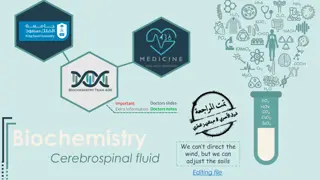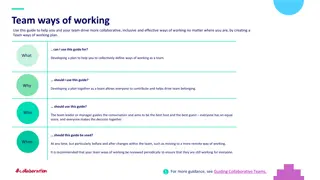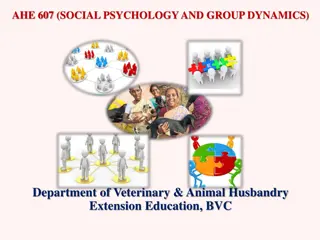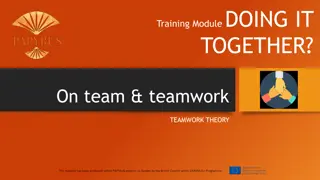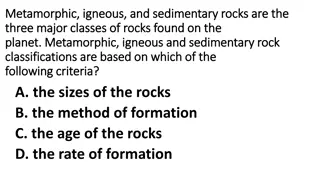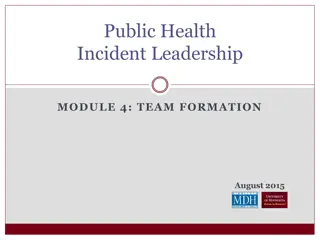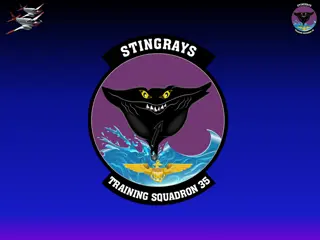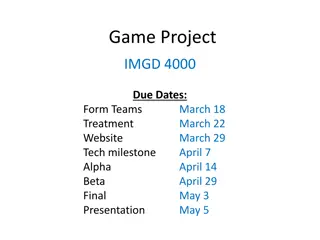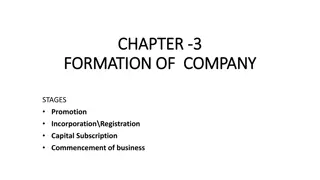Understanding Tuckman's Model of Team Formation
Explore the stages of team development according to Bruce Tuckman's model, from Forming to Performing and Adjourning. Learn how to navigate interpersonal dynamics, build effective teams, and achieve academic and career success through teamwork. Discover key insights into team roles, dynamics, and leadership approaches essential for creating high-performing teams.
Download Presentation

Please find below an Image/Link to download the presentation.
The content on the website is provided AS IS for your information and personal use only. It may not be sold, licensed, or shared on other websites without obtaining consent from the author. Download presentation by click this link. If you encounter any issues during the download, it is possible that the publisher has removed the file from their server.
E N D
Presentation Transcript
Tuckmans Model of Team Formation By A. Student ENGR240 Introduce topic and self in the first slide
Power statement get audience on board Why Learn about Teamwork? Design work is generally done in teams. Being an effective team member is critical to our academic and career success. Current classmates may be future colleagues, or even bosses
Questions you may have Get audience input How do interpersonal dynamics work? What can I expect from my teammates and team leader in terms of behaviour and expectations? What is a successful, high-performing team? How can I help to turn mine into one?
Bruce Tuckman Some relevant background An American psychologist Did research with the navy into small-group dynamics: what makes teams succeed, what makes them fail? Isolated teams, stressful conditions Reviewed the psychological literature on team dynamics Generalized to a staged theory of the development of small groups
Overview Slide The Tuckman Model Forming 1. Bruce Tuckman, The Tuckman model of team formation published in Psychological Bulletin in 1965 Storming Norming 1. Tuckman and Mary Ann Jensen, Stages of small-group development revisited published in Group & Organisational Studies in 1977. Added Adjourning/Mourning. Performing 1. Then refined and updated continuously by other researchers. Adjourning
Elaborations to the model Forming Storming Forming Storming Norming Performing Adjourning Adjourning Performing Norming
Forming Stage Elaboration of first key idea presented in the overview Get to know teammates, their strengths and weaknesses Develop trust; try team-building activities Think about selecting roles, team leaders Start to focus on task definition, purpose Dynamics characterized by Careful body language, polite speech, small talk Anxiety, fear of causing offense, conservative tone and gestures, ready laughter Leaders: focus on creating team structures, developing clear team rules/guidelines, professional environment. Paperwork (agendas, minutes, bylaws, etc.) can reduce anxiety.
Storming Elaboration of 2nd key point Brainstorm solution ideas. Test opinions and assumptions. Work habits are revealed. Frustration, conflict appear. Team members: respect and maturity are critical. Depersonalize conflicts. Address/critique IDEAS, not people. Leaders: Assertive, not aggressive or passive. What do we want to accomplish? Leader s role is to help team members do their best work to achieve team goal.
Norming Elaboration of 3rd key point Team members are aware of their roles. Norms of behaviour appear; expectations are known. Body language, speech, terms of address become more relaxed. Implicit as well as explicit rules established. we and us replacing me and I Taking individual responsibility for group decisions. Willingness to compromise and abide by team decisions. Leaders: Time to back off. Monitor and enable; be ready to reassert if necessary. Ask audience for suggestions: what might be an implicit rule ?
Performing Elaboration of 4th key point Synergy Self directed, but oriented to team goals Team members support one another Enjoy yourself! (Few teams reach this stage, and usually only after working on several projects together) Leaders: Stay out of the team s way. Now a facilitator. Define synergy ?
Elaboration of 5th Key point Adjourning / Mourning End of project or departure of member Take pride in your work. Celebrate success! Review lessons learned Enjoy group loyalty, but beware of avoidant behaviour / formation of cliques.
Example of end of project celebration Skyrim Development Team Photo [6]
Draw on previous material; highlight important take-aways Insights Conflict during the Storming stage is NOT a sign of a defective team it s a necessary and productive precondition for success and innovative thinking. Conflict can be productive if handled well, but destructive if managed poorly. It s OK to return to a previous stage if circumstances warrant.
Engage audience in discussion about potential issues get critical feedback? Potential issues Stage metaphor what if stages are missed? Causation what allows movement between stages? Pedagogical concerns Self-fulfilling prophecy? Generalizability
Conclusion Summation/wrap up Tuckman s model and its derivatives are powerful, insightful and useful tools for understanding your team dynamics, but his stages are not necessarily prerequisites for success, and this is not the only successful model of successful teamwork. Think for yourself apply your own critical thinking capacity to your team experience.
Any Questions? Give audience a chance to ask questions and have further input/discussion
Provide references and sources for further study Thank you! References [1] B. W. Tuckman, Developmental sequence in small groups , Psychological Bulletin #63(6), pp. 384-399, 1965. [2] B. W. Tuckman, and M. C. Jensen, Stages of small-group development revisited , Group & Organizational Studies (pre 1986), p. 419, 1977. [3] M. K. Smith, Bruce W Tuckman forming, storming, norming and performing in groups , infed.org: The Encyclopedia of Informal Education, 2005. http://infed.org/mobi/bruce-w- tuckman-forming-storming-norming-and -performing-in-groups/. Retrieved Feb 26, 2016. [4] A. C. Hurt and S. M. Trombley, The punctuated Tuckman: towards a new group development model. Texas A&M University, 2007. http://www.eric.ed.gov/PDFS/ED504567.pdf Retrieved Feb 26, 2016. [5] S. McCahan, et al., Introduction to teamwork, in Designing Engineers: An Introductory Text. Wiley, 2015, pp 2019-246. [6] Skyrim: Development Team [Photo]. Available: http://en.uesp.net/wiki/Skyrim:Development_Team





